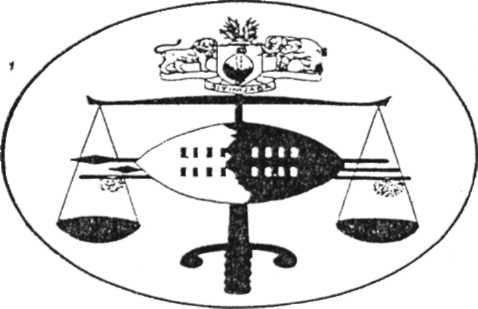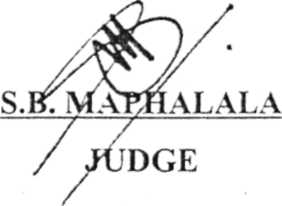1
THE HIGH COURT OF SWAZILAND EMALANGENI FOODS (PTY) LIMITED Plaintiff And FREEWAY CENTRE (PTY) LIMITED 1st Defendant LUCY NTOMBIZODVWA GAMA 2nd Defendant Civil Case No. 3126/2002 S.B. MAPHALALA - J MR. K. MOTSA MR. A. LUKHELE JUDGMENT (23/04/2004) Coram For the Plaintiff For the Defendants
Before court is an opposed summary judgment application. The causa arose this way. On the 15lh February 2002, the 2nd Defendant requested in writing that a credit facility existing between Plaintiff and 1st Defendant be extended.
division. This guarantee shall be a continuing guarantee which may only be cancelled bythe purchase's notice in writing to Emalangeni Foods (Pry) Ltd and then provided that all amounts then owing by the purchaser to Emalangeni Foods (Pry) Ltd have been paid in full and provided further that Emalangeni Foods (Pry) Ltd accedes to such cancellation in writing. Notwithstanding that this document contemplates more than one such surety, there shall be a separate suretyship by each person who signs as surety and should a co-surety not be liable at all or in full for whatever reason, the other surety/ies shall nevertheless be liable in full. Emalangeni Foods (Pry) Ltd shall have the right to extend the time for payment by the purchaser or release the purchaser or any surety herefrom and this shall not be deemed to be a novation of the terms of this and shall not affect the liability of each surety to Emalangeni Foods (Pry) Ltd. Any two or more persons liable to Emalangeni Foods (Pty) Ltd under this agreement shall be jointly and severally liable". The Defendant raised a point in limine that the Plaintiffs summons did not contain the necessary averments to sustain a cause of action on the deed of suretyship, in particular that Plaintiff s summons do not allege a valid contract of suretyship and the causa in respect of which she undertook liability. This aspect of the matter was argued and the court in a judgment delivered on the 31st October 2003 dismissed the point in limine and reserved costs to the merits. The matter was argued on the merits on the 29th March 2004. The Defendant's defence on the merits is what appears in paragraphs 3.1 and 3.2 of the answering affidavit. The defence is as follows: "3.1 The judgment obtained against Freeway Centre (Pty) Ltd has not been executed properly against the company as such the judgment has to be executed first against the company and then against me. 3.2 Further, 1 deny that the amount obtained on execution of the goods of Freeway Centre (Pty) Limited is as alleged and Plaintiff is put to strict proof thereof'. The Plaintiff replied to the above allegation in its affidavit as follows: "7. AD paraizranh 3.
7.1 Plaintiff submits that 2"J Defendant by signing as co-principal debtor renounced the 7.2 In any event the sale (annexure "E4" was conducted by an appointed Deputy Sheriff In argument Mr. Motsa for the Plaintiff argued that a copy of the Sheriffs return of the Distribution Account, Sale in Execution, Movable Goods attached to the pleadings clearly show that the sale was properly constituted and that the Plaintiff had in fact firstly executed against the 1st Defendant, but was not able to satisfy its claim. The second argument advanced for the Plaintiff is that the 2 Defendant's claim that the amount of money is not as in the credit application, is irrelevant. The amount agreed upon in the credit application is for an expected monthly purchase in the amount of E400, 000-00, which is in excess of the amount claimed by the Plaintiff. The outstanding amount of money is easily calculated and therefore constitutes a liquid amount of money which entitles the Plaintiff to proceed against the Defendants on the basis of summary judgment. Thirdly, it is contended for the Plaintiff that the 2nd Defendant does not deny that the 1st Defendant, to whom she has bound herself as surety, owes the money to the Plaintiff, she merely denies that she can be held liable as a co-principal debtor, and thereby does not disclose a bona fide defence to the Plaintiffs claim. Mr. Lukhele for the Defendant argued that there was no proper execution of the judgment in this case. Secondly, the nature and amount of the principal debt is not capable of ascertainment by reference to the document annexed as a deed of suretyship. In this regard the court was referred to Aimer's Precedents of Pleadings (3ru ED) and Harms, page 281 — 285. The gravamen of Mr. Lukhele's arguments is that there are triable issues in this case. There are three issues for determination in this case, firstly, the issue of whether execution was proper; secondly, the issue of whether the debt is a liquidated amount in terms of Rule 32 (2) of the High Court Rules, and thirdly, whether the Defendant has disclosed a bona fide defence in accordance with the requirements of the section.
- benefit of excursion hence her argument ought to fail. -
hence this is conclusive evidence".
On the issue of the execution of the judgment in the present case, it appears that the Plaintiff has in fact executed against the ls: Defendant and only upon not having been satisfied, it is now seeking to execute against the 2nd Defendant. The 2nd Defendant had not only bound herself as surety, but as a co-principal debtor. The writ of execution was duly issued and the Sheriff of the High Court duly sold the property of the 1st Defendant on public auction which was properly constituted. This is reflected in annexure "E4" being a return, distribution account of sale in execution of movable goods. The document reflects ex facie that the public auction yielded a purchase price of E7, 050-00 plus a sum of El 13, 00 in the cash register at Freeway Centre by the bus rank. From the total sum Sheriffs costs and disbursement of E3, 222-30 was taken and a sum of E3, 940-70 was execution costs owed to the Plaintiffs attorney. Therefore, I hold that the sale (annexure "E4") was conducted by an appointed Deputy Sheriff hence this is conclusive evidence. On the second issue raised viz whether the debt is a liquidated amount in terms of Rule 32 (2) I hold that it is a liquidated amount. In terms of Rule 32 of the rules of this court, summary judgment can be granted upon a claim for a liquidated amount. The rule provides as follows: 32 "1. Where in an action to which this rule applies and a combined summons has been served on a Defendant or a declaration has been delivered notice of intention to defend, the Plaintiff may, on the ground that the Defendant has no defence to a claim included in the summons, or to a particular part of such a claim, apply to the court for summary judgment against that Defendant. 2. This rule applies to such claims in the summons as is only: (a) (b) For a liquidated amount in money. (c) (d) " A claim cannot be regarded as one for a "'liquidated amount in money" unless it is based on an obligation to pay an agreed sum of money or is so expressed that the
ascertainment of the amount is a mere matter of calculation, (see Botha vs Swanson & Company (Pty) Ltd 19158 (2) P.H. F85 (CPD) as per CorbettJ). ~ The Plaintiff, when basing the application for summary judgment on a mortgage bond or a surety can claim less than the amount of the bond or the suretyship. This he can do without explaining whether the mortgagor has made payments in reduction of the capital amount of the bond or whether there is some other reason for claiming less than what the bond warrants. The difference between the full amount of the bond, or the outstanding amount in terms of the suretyship and the amount claimed need not be abandoned (see African Credit and Investment Corporation Ltd vs Hyde 1930 WLD 146 at 149-50 and Western Bank Ltd vs Packery 1977 (3) S.A. 137 (T) at 760E). Further, where the claim is for a balance due and in arrear on an open account over a stated period, it is generally looked upon as a combined cause of action "based on the grounds referred to in the summons" or words to that effect, are sufficient compliance with the rule. In casu, it is my opinion that the outstanding amount of money is easily calculated and therefore constitutes a liquid amount of money which entitles the Plaintiff to proceed against the Defendants on the basis of summary judgment. Annexure E3 of page 13 of the Book of Pleadings sets out the amount due and the calculation thereof. The third and last issue for determination is whether the 2nd Defendant has disclosed a bona fide defence to satisfy the requirement of Rule 32. In order for the Defendant to succeed by not having summary judgment granted against him, he must show that he has a bona fide defence. For the court to make the decision whether the Defendant has set out his defence all the needs to show is whether the Defendant has disclosed the nature and grounds of his or her defence, and whether, on the facts so disclosed the Defendant appears to have, as to either the whole or part of the claim, a defence which is bona fide and good in law. (see Muharah vs Barclays National Bank Ltd 1976 (1) S.A. 418 (A) at 427). Whether the defence is bona fide or not depends upon the merits of that defence raised in the Defendant's replying affidavit (see Silverleaf Pastry and Confectionary Co. (Pty) Ltd vs Joubert 1972 (1) S.A. 125 (c) at 129).
The rule does not require the Defendant to establish his bona fides, only the bona fides of his defence. Following the legal principles outlined above, it appears that in the present case the only defence the 2nd Defendant relies on in her affidavit is that the judgment obtained against the 1st Defendant has not been executed properly against the company and as such the judgment had to be executed first against the 1st Defendant and only then against the 2nd Defendant. In casu no bona fide whatsoever is disclosed. For the above-mentioned reason I hold that the Plaintiff is entitled to summary judgment in terms of prayer 1, 2 and 3 on the notice of application for summary judgment; and it is so ordered.
